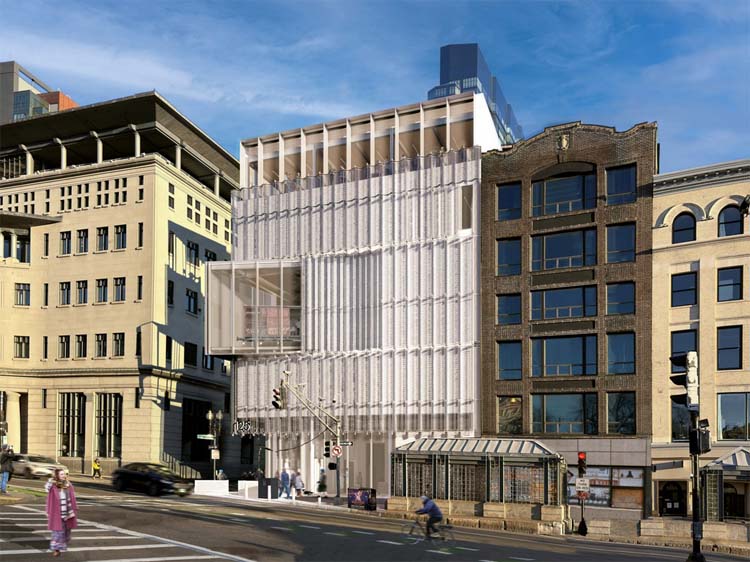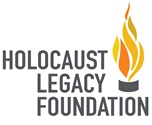By James McCown Globe Correspondent
Updated June 5, 2023, 7:00 a.m.
The building would be near Boston Common, along the Freedom Trail, by the intersection of Park and Tremont streets

A view of the proposed Holocaust Museum Boston as it would appear from Boston Common.Courtesy Schwartz/Silver Architects
The Boston-based Holocaust Legacy Foundation has unveiled renderings of its proposed Holocaust Museum Boston, to be located along the Freedom Trail, by the intersection of Tremont and Park streets. Judging from the renderings and discussions with the architect, Schwartz/Silver, the design is a modernist counterpoint to the Christopher Wren-inspired Park Street Church, located across Tremont Street, and Tsoi Kobus Design’s postmodern David J. Sargent Hall at Suffolk University Law School, located just to the northeast, along Tremont.
The design of the museum feels just right for where and what it is. On a tight, heavily traveled site, it is resolutely vertical — six stories and 32,700 square feet of exhibition and educational space. The entrance is not on Tremont but rather around the corner, on quieter Hamilton Place, allowing better crowd control.
The building’s most powerful element is conceptual. You begin by taking an elevator to the fifth floor. There a central stairway is bathed in natural light. As you descend into the exhibits, light is replaced with darkness, with exhibits chronicling the atrocities of the Nazi regime. As you make your way down, there is gradually more light until you finally end up in a sun-washed lobby.
“Although the exhibits will be dark in character, we wanted the building itself to be hopeful,” said Jonathan Traficonte, design principal of the project for Schwartz/Silver. The structure will be sheathed in undulating woven stainless-steel mesh, which Traficonte said alludes to the drawn curtains of Jews and other groups targeted by the Third Reich. The big architectural gesture on the main façade is an angled window that will make visible a railcar that was used to transport Holocaust victims to the death camps.
“The angled window represents the Nazis tearing through the curtains,” Traficonte explained. “It represents the moment of fracture when freedom was lost.”
Boston already has the superb New England Holocaust Memorial by architect Stanley Saitowitz, at 98 Union St., just east of City Hall — so why a museum?
“We feel there is a need. Our mission is to preserve and perpetuate [the] memory of the Holocaust for future generations,” said Jody Kipnis, founding president and CEO of the Holocaust Legacy Foundation, which while aimed at a wide audience has a special emphasis on educating youth. “We also want to connect the Holocaust to modern-day injustices.”
As required, the foundation will file its renderings with the Boston Planning and Development Agency on Monday. It has several hurdles: approval by the BPDA; the Boston Landmarks Commission approving the razing of an existing mid-century neo-Georgian building; and review by the Boston Civic Design Commission.
The majority of the space will be a permanent collection arranged by Luci Creative, a Chicago-based design firm with an office in Boston. Luci is responsible for the exhibit design at the Illinois Holocaust Museum and Exhibition Center, in Skokie, which was a venue for a proposed neo-Nazi march in the late 1970s. The gallery on the first floor of the Boston museum will be for changing and traveling exhibitions.
One of the permanent exhibits will be the Dimensions in Testimony Theater, to be installed in collaboration with the USC Shoah Foundation, started by Steven Spielberg. Featured on “60 Minutes,” the theater uses advanced technology that will allow visitors to pose questions to Holocaust survivors and have them answered in real time, even if the interviewee is no longer alive. With the majority of Holocaust survivors in their 80s and 90s, the exhibit will fill an urgent need.
“If thou didst ever hold me in thy heart, absent thee from felicity awhile, and in this harsh world draw thy breath in pain, to tell my story,” says a dying Hamlet.
This is the burden of mankind — to tell the stories of the Holocaust. The siting and design of the proposed Holocaust Museum Boston are exceptional. One can imagine a completed structure with the railcar lit up and visible at night through the large window.
“I never dreamed we would be able to acquire a site on the Freedom Trail,” said Kipnis. “We were just in the right place at the right time.” While she declined to give the projected construction cost of the museum, she said that 50 percent of the funding has already been raised.
The Wu administration and its various agencies would do well to approve the project.
James McCown is an architectural journalist who lives in Newton. This fall Rizzoli will publish his “The Home Office Space: Pavilions, Shacks and Extensions for Optimum Inspiration and Productivity.”
